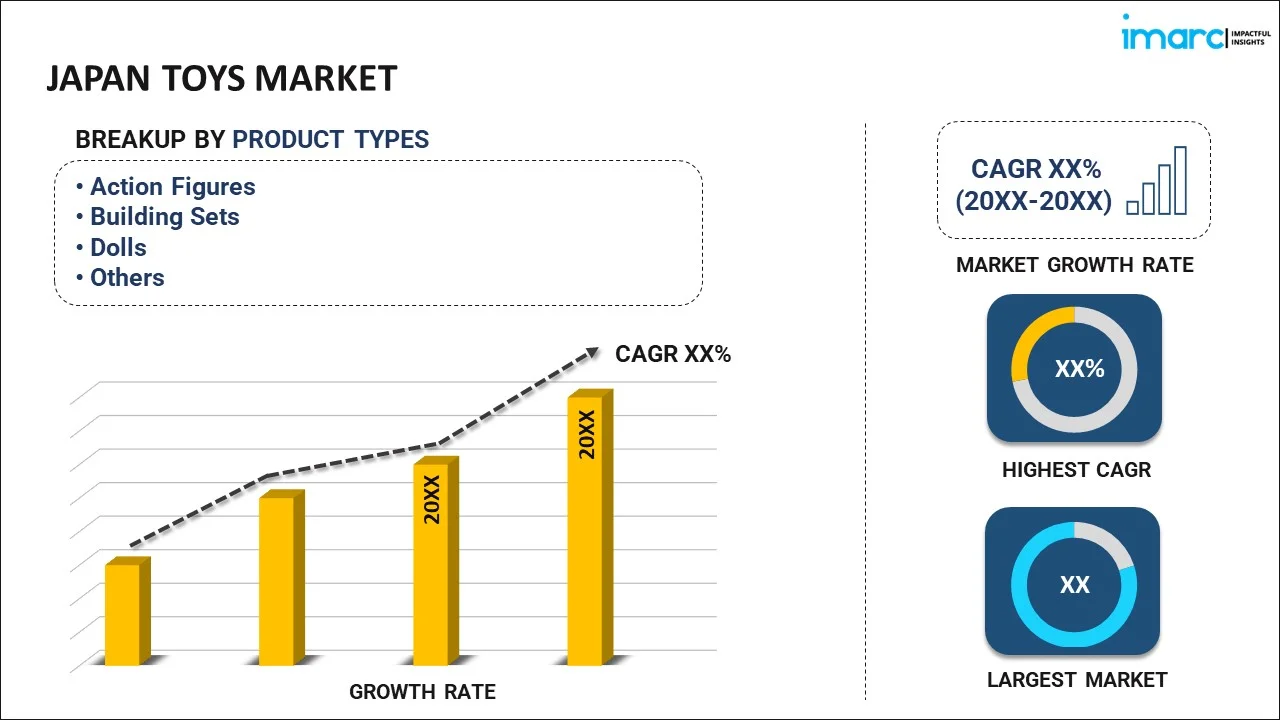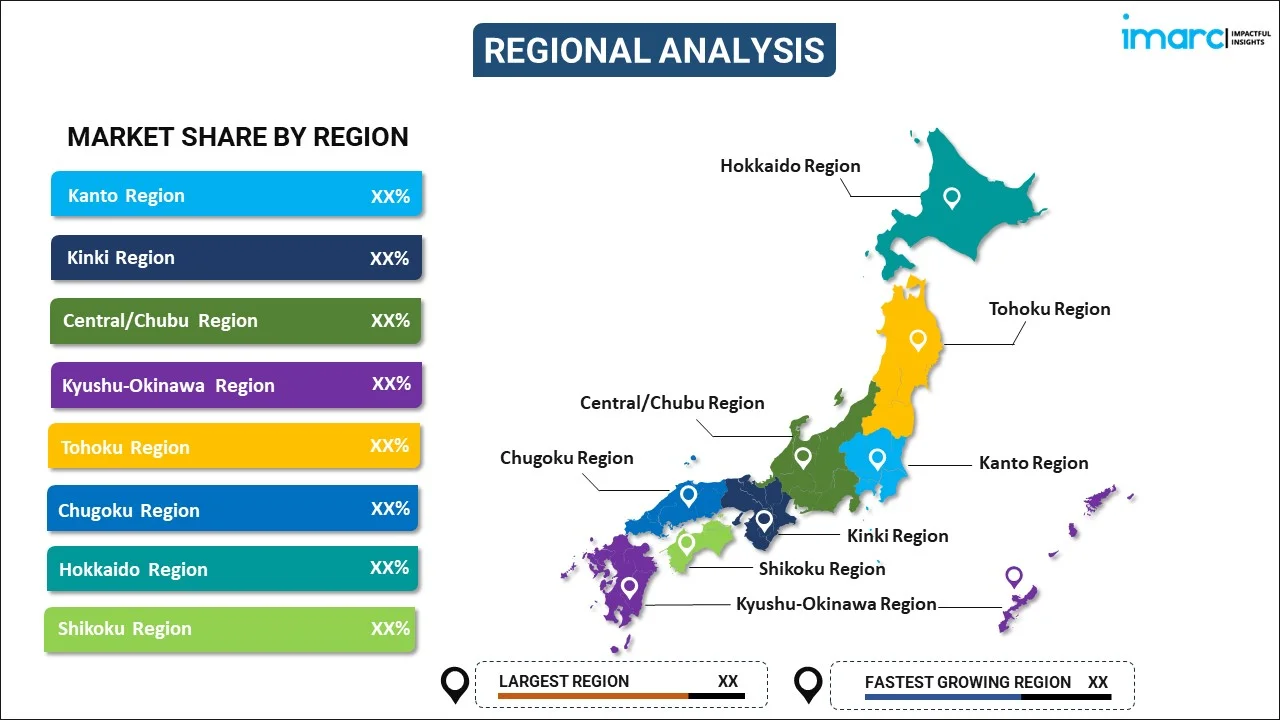
Japan Toys Market Report by Product Type (Action Figures, Building Sets, Dolls, Games and Puzzles, Sports and Outdoor Toys, Plush, and Others), Age Group (Up to 5 Years, 5 to 10 Years, Above 10 Years), Sales Channel (Supermarket and Hypermarket, Specialty Stores, Department Stores, Online Stores, and Others), and Region 2025-2033
Market Overview:
The Japan toys market size is projected to exhibit a growth rate (CAGR) of 3% during 2025-2033. The growing demand for educational toys and play-based learning tools among the masses, the introduction of a diverse array of interactive product variants and the integration of cutting-edge technologies in the products represent some of the key factors driving the market.
|
Report Attribute
|
Key Statistics
|
|---|---|
|
Base Year
|
2024
|
|
Forecast Years
|
2025-2033
|
|
Historical Years
|
2019-2024
|
| Market Growth Rate 2025-2033 | 3% |
Toys are playthings or objects designed to provide entertainment, amusement, and engagement for children and, in some cases, even for adults. They generally come in various shapes, sizes, and forms, catering to a wide range of interests and age groups. The primary purpose of toys is to stimulate a child's imagination, creativity, and cognitive abilities, contributing to their overall development. Toys have evolved significantly over time, not only in their design and features but also in the materials used to create them. In the past, toys were often handcrafted from natural materials, such as wood, clay, or fabric. These traditional toys showcased the artisanal skills of craftsmen and were treasured for their uniqueness and cultural significance. In Japan, as in many other countries, the significance of toys extends beyond mere leisure; they play a crucial role in educational and social development. Traditional Japanese toys often reflect the country's rich cultural heritage and values, while modern toys incorporate cutting-edge technology to enhance the play experience. As the market continues to evolve, toy manufacturers and retailers in Japan attempt to deliver innovative, safe, and entertaining products that capture the minds of their young consumers.
Japan Toys Market Trends:
The Japan toys market is experiencing robust growth, driven by the growing demand for educational toys and play-based learning tools among the masses. With an increasing emphasis on early childhood education, parents and educators alike recognize the vital role of toys in fostering cognitive, motor, and social skills during a child's formative years. As a result, there is a rising preference for toys that combine entertainment with educational elements, stimulating children's curiosity and facilitating learning through play. Manufacturers are responding to this demand by introducing a diverse array of interactive and educational toys that align with the country's educational curriculum, ensuring their relevance and effectiveness in nurturing young minds. Moreover, the integration of technology into toys has emerged as a major driving force in the Japan market. With the proliferation of digital devices and the prevalence of technology-driven lifestyles, tech-enabled toys have gained immense popularity among tech-savvy consumers. Smart toys, interactive games, and augmented reality (AR) experiences have captivated children, providing them with a new dimension of play. To stay competitive, toy companies are investing in research and development to incorporate cutting-edge technologies seamlessly into their products. Furthermore, connectivity features that enable interaction between toys and digital platforms are becoming increasingly common, providing children with a holistic and immersive play experience.
Japan Toys Market Segmentation:
IMARC Group provides an analysis of the key trends in each segment of the Japan toys market report, along with forecasts at the country level for 2025-2033. Our report has categorized the market based on product type, age group, and sales channel.
Product Type Insights:

- Action Figures
- Building Sets
- Dolls
- Games and Puzzles
- Sports and Outdoor Toys
- Plush
- Others
The report has provided a detailed breakup and analysis of the market based on the product type. This includes action figures, building sets, dolls, games and puzzles, sports and outdoor toys, plush and others.
Age Group Insights:
- Up to 5 Years
- 5 to 10 Years
- Above 10 Years
A detailed breakup and analysis of the market based on the age group has also been provided in the report. This includes up to 5 years, 5 to 10 years and above 10 years.
Sales Channel Insights:
- Supermarket and Hypermarket
- Specialty Stores
- Department Stores
- Online Stores
- Others
The report has provided a detailed breakup and analysis of the market based on the sales channel. This includes supermarket and hypermarket, specialty stores, department stores, online stores and others.
Regional Insights:

- Kanto Region
- Kinki Region
- Central/ Chubu Region
- Kyushu-Okinawa Region
- Tohoku Region
- Chugoku Region
- Hokkaido Region
- Shikoku Region
The report has also provided a comprehensive analysis of all the major regional markets, which include Kanto Region, Kinki Region, Central/ Chubu Region, Kyushu-Okinawa Region, Tohoku Region, Chugoku Region, Hokkaido Region and Shikoku Region.
Competitive Landscape:
The report has also provided a comprehensive analysis of the competitive landscape in the Japan toys market. Competitive analysis such as market structure, key player positioning, top winning strategies, competitive dashboard, and company evaluation quadrant has been covered in the report. Also, detailed profiles of all major companies have been provided.
Report Coverage:
| Report Features | Details |
|---|---|
| Base Year of the Analysis | 2024 |
| Historical Period | 2019-2024 |
| Forecast Period | 2025-2033 |
| Units | Million USD |
| Scope of the Report | Exploration of Historical and Forecast Trends, Industry Catalysts and Challenges, Segment-Wise Historical and Predictive Market Assessment:
|
| Product Types Covered | Action Figures, Building Sets, Dolls, Games and Puzzles, Sports and Outdoor Toys, Plush, Others |
| Age Groups Covered | Up to 5 Years, 5 to 10 Years, Above 10 Years |
| Sales Channels Covered | Supermarket and Hypermarket, Specialty Stores, Department Stores, Online Stores, Others |
| Regions Covered | Kanto Region, Kinki Region, Central/ Chubu Region, Kyushu-Okinawa Region, Tohoku Region, Chugoku Region, Hokkaido Region, Shikoku Region |
| Customization Scope | 10% Free Customization |
| Post-Sale Analyst Support | 10-12 Weeks |
| Delivery Format | PDF and Excel through Email (We can also provide the editable version of the report in PPT/Word format on special request) |
Key Questions Answered in This Report:
- How has the Japan toys market performed so far and how will it perform in the coming years?
- What has been the impact of COVID-19 on the Japan toys market?
- What is the breakup of the Japan toys market on the basis of product type?
- What is the breakup of the Japan toys market on the basis of age group?
- What is the breakup of the Japan toys market on the basis of sales channel?
- What are the various stages in the value chain of the Japan toys market?
- What are the key driving factors and challenges in the Japan toys market?
- What is the structure of the Japan toys market and who are the key players?
- What is the degree of competition in the Japan toys market?
Key Benefits for Stakeholders:
- IMARC’s report offers a comprehensive quantitative analysis of various market segments, historical and current market trends, market forecasts, and dynamics of the Japan toys market from 2019-2033.
- The research study provides the latest information on the market drivers, challenges, and opportunities in the Japan toys market.
- Porter's five forces analysis assist stakeholders in assessing the impact of new entrants, competitive rivalry, supplier power, buyer power, and the threat of substitution. It helps stakeholders to analyze the level of competition within the Japan toys industry and its attractiveness.
- Competitive landscape allows stakeholders to understand their competitive environment and provides an insight into the current positions of key players in the market.
Need more help?
- Speak to our experienced analysts for insights on the current market scenarios.
- Include additional segments and countries to customize the report as per your requirement.
- Gain an unparalleled competitive advantage in your domain by understanding how to utilize the report and positively impacting your operations and revenue.
- For further assistance, please connect with our analysts.
 Inquire Before Buying
Inquire Before Buying
 Speak to an Analyst
Speak to an Analyst
 Request Brochure
Request Brochure
 Request Customization
Request Customization




.webp)




.webp)












